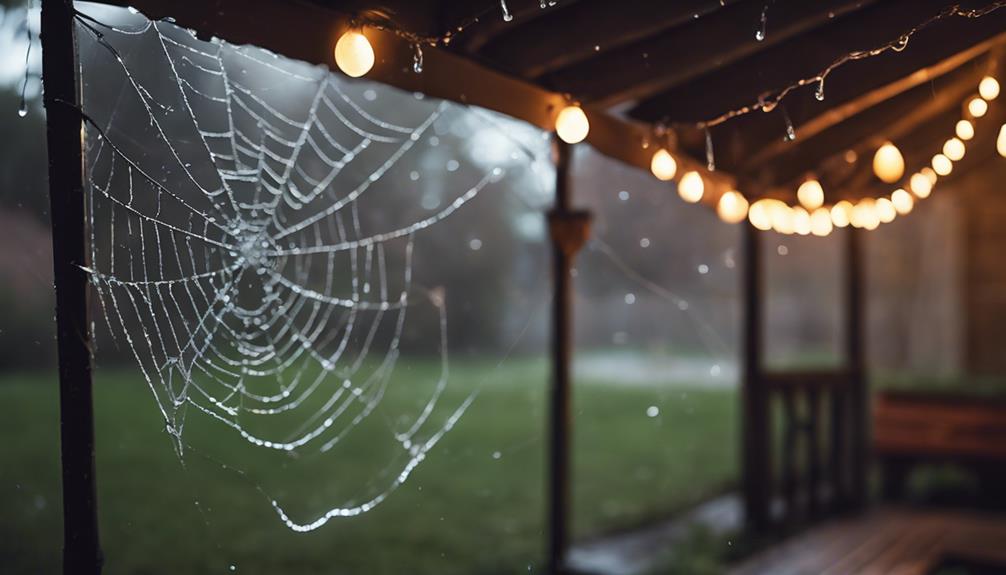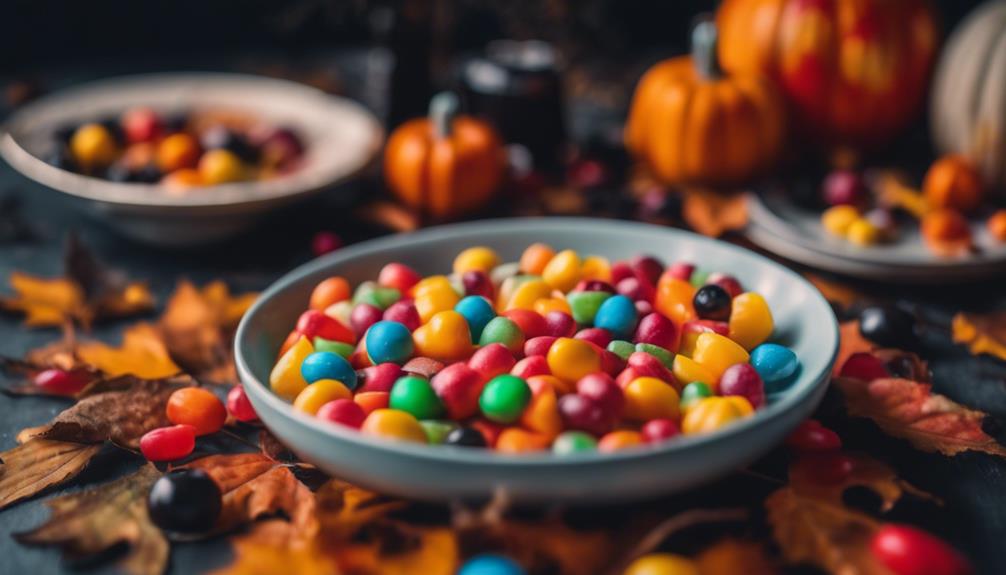To protect Halloween spider webs from getting wet, consider using a clear waterproof spray like Krylon. Apply it evenly on the webs to create a moisture barrier. Place the webs in covered areas such as porches or under awnings to shield them from rain. If the webs get wet, gently pat them dry with a soft cloth and avoid heat sources for drying. Experiment with different waterproofing methods for best results. For more detailed techniques on maintaining spooky spider webs during Halloween, explore alternative waterproofing techniques and preservation methods.
Key Takeaways
- Use clear Krylon spray or gloss finish for waterproofing spider webs.
- Experiment with different waterproofing methods like hot glue or baby powder.
- Shelter spider webs in covered areas like porches to shield them from moisture.
- Gently pat wet spider webs with a soft cloth and air dry naturally.
- Maintain the spooky appearance by avoiding excess moisture during preservation.
Choosing the Right Waterproof Spray
Consider using a clear Krylon spray can for waterproofing spider webs to protect them from moisture, especially during the damp times of year like autumn. This type of spray provides a transparent coating that can shield the delicate spider webs from getting wet and losing their intricate structure. By applying this waterproof spray to the spider webs, you can guarantee they remain intact and visually appealing even when exposed to rain or humidity.
Choosing the right waterproof spray is essential in preserving the spider webs for extended periods, especially if you plan to display them outdoors. The clear Krylon spray can effectively seal the webs, keeping them safe from moisture damage. It's important to take into account the time of year when applying the spray, as certain seasons may require more frequent reapplications to maintain the waterproofing effect. Experimenting with different waterproofing methods will help you determine the most suitable option to protect your spider webs effectively.
Applying Waterproof Spray to Spider Webs
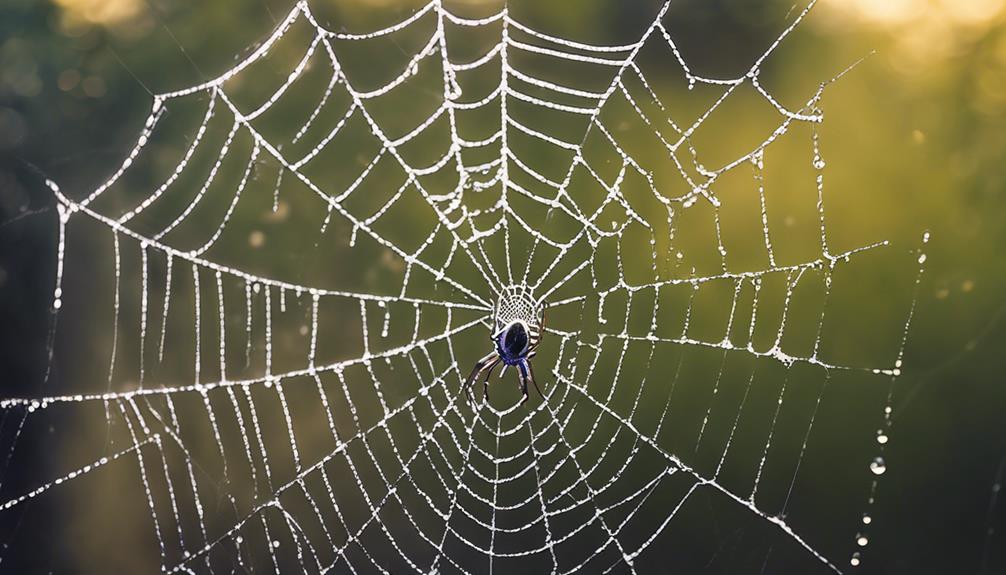
When applying waterproof spray to spider webs, make sure there's even coverage to effectively protect them from moisture. This step is essential in preserving your Halloween decorations and keeping them looking spooky all season long.
Waterproof Spray Application
To waterproof spider webs effectively, apply a clear Krylon spray or gloss finish to create a protective barrier against moisture. These waterproof sprays form a shield on the spider webs, safeguarding them from moisture-related damage. Testing out various waterproofing methods can help you ascertain the most suitable one for your spider webs.
You might also want to contemplate using a glue stick web gun or hot glue from a web caster gun to make the webs waterproof. Additionally, enhancing visibility and weatherproofing can be achieved by incorporating materials like baby powder, fullers earth, or diatomaceous earth.
Protecting From Moisture
For effective protection against moisture, apply a clear Krylon spray or gloss finish to waterproof your Halloween spider webs. Testing different waterproofing methods is crucial to guarantee that the spray can effectively withstand moisture.
To further enhance the durability of your spider webs, you may also consider using a glue stick web gun or hot glue from a web caster gun for added waterproofing.
Additionally, to improve visibility and weatherproofing, you can apply substances like baby powder, fullers earth, or diatomaceous earth to the webs. Experimenting with various weatherproofing techniques will help you determine the most suitable option for safeguarding your Halloween spider webs from getting wet.
Preserving Halloween Decorations
Applying a waterproof spray, such as clear Krylon or gloss/semi-gloss finish, effectively safeguards Halloween spider webs from moisture.
To make sure your spooky decorations remain intact and dry during outdoor use, it's important to test waterproofing methods. Consider using a glue stick web gun or hot glue from a web caster gun for a waterproof finish on spider webs.
Additionally, materials like baby powder, fullers earth, or diatomaceous earth can be used for both visibility and weatherproofing of spider webs.
Experimenting with different waterproofing techniques can help you find the most suitable method for preserving your Halloween spider decorations. By taking the time to apply a waterproof spray and explore alternative methods, you can enjoy your spooky spider webs without worrying about them getting ruined by rain or damp weather.
Give your Halloween decorations the protection they need to stay spooky and festive throughout the season!
Placing Spider Webs in Covered Areas
Consider finding a sheltered spot, such as a porch or under an awning, to preserve the Halloween spider webs from moisture. Placing the spider webs in covered areas like these can shield them from rain and humidity, maintaining their spooky allure. By opting for covered locations, you safeguard the integrity and appearance of the spider webs, ensuring they remain in top condition for your Halloween decorations.
Avoid exposing the spider webs to open or unprotected areas where they're vulnerable to getting wet and losing their eerie effect. Covered spots not only protect the webs from moisture but also prevent wind from tangling or damaging them during your Halloween displays. This strategic placement enhances the durability of the spider webs, guaranteeing they uphold their scary and festive look throughout the Halloween season.
Dealing With Wet Spider Webs
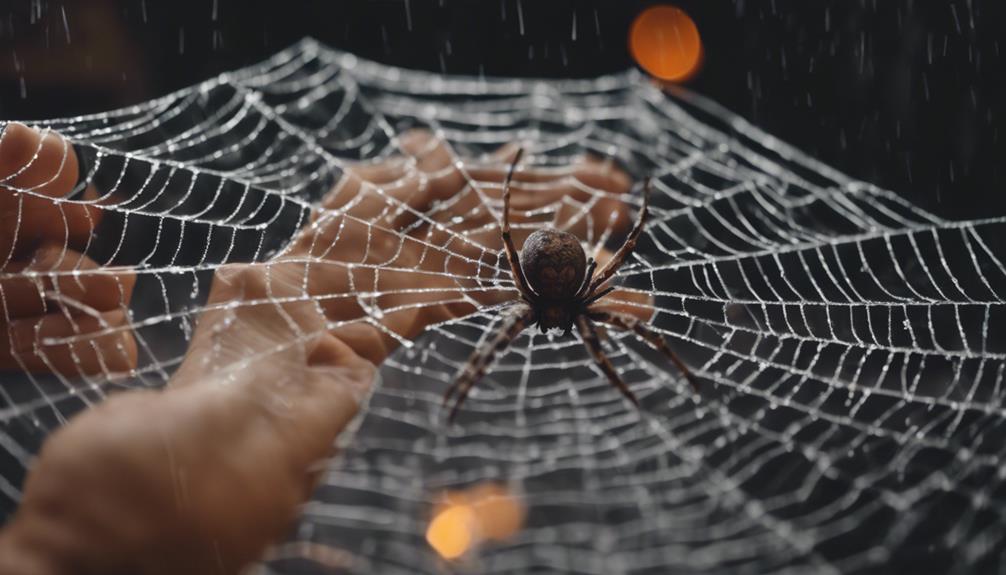
To preserve Halloween spider webs from moisture, utilize waterproofing sprays like clear Krylon or gloss finish. These sprays form a protective barrier that prevents water from seeping into the delicate web fibers. Additionally, consider using waterproof materials such as synthetic spider webs or beef netting for increased durability, especially if your decorations will be exposed to outdoor conditions. Experiment with alternative waterproofing techniques like applying hot glue from a web caster gun or using baby powder for weatherproofing.
It is important to maintain and stretch spider webs regularly to prevent sagging, which can lead to water accumulation. By keeping the webs taut, you reduce the risk of them becoming waterlogged. Remember to reapply waterproofing methods consistently to make sure that the spider webs stay dry and intact throughout your Halloween displays. By taking these proactive steps, you can effectively deal with wet spider webs and preserve the spooky atmosphere of your decorations.
Drying Wet Spider Webs Properly
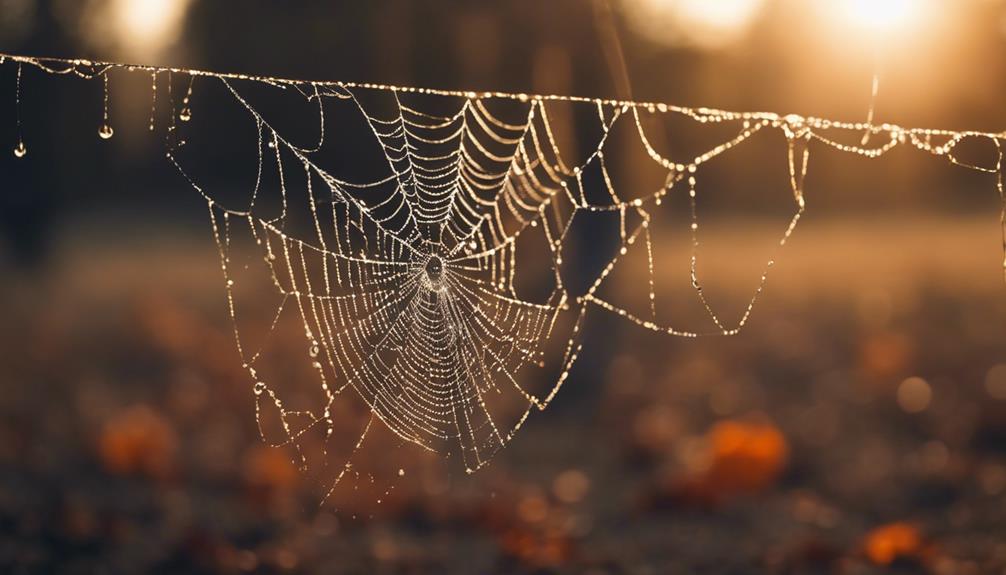
When drying wet spider webs properly, remember to gently pat them with a soft cloth to remove excess moisture.
Avoid using heat sources like hairdryers or direct sunlight, as they can harm the delicate structure of the web.
Let the spider webs air dry naturally in a well-ventilated area to maintain their integrity and prevent mold growth.
Proper Web Handling
When drying wet spider webs properly, gently pat them with a soft cloth or paper towel to remove excess moisture without damaging the delicate strands. Handling wet spider webs with care and patience is important during the drying process to preserve their intricate design and prevent them from losing their spooky appeal. Avoid using heat sources such as hair dryers or direct sunlight, as these can cause the web to shrink or become brittle. Instead, allow the wet spider webs to air dry naturally in a cool, dry place to maintain their structural integrity and prevent them from sticking together.
| Proper Web Handling Tips | Benefits |
|---|---|
| Gently pat wet webs with a soft cloth | Prevents damage to delicate strands |
| Avoid heat sources for drying | Maintains web integrity |
| Allow air drying in a cool place | Prevents webs from sticking together |
| Handle with care and patience | Preserves intricate design |
| Ensure spooky appeal remains | Ready for Halloween display |
Air Drying Method
For proper preservation of wet spider webs, consider employing the air drying method in a well-ventilated area to prevent damage. Here are some steps to effectively air dry your wet spider webs:
- Hang the wet spider webs in a well-ventilated area: Choose a spot with good airflow to help the spider webs dry faster and more evenly.
- Avoid direct sunlight: Direct sunlight can cause the delicate spider webs to become brittle or discolored, so opt for a shaded area instead.
- Be patient: Drying spider webs naturally may take some time, especially in humid conditions. Allow them ample time to air dry completely.
- Check for dryness: Once the spider webs are no longer wet to the touch and have fully dried, they'll be ready to regain their shape and stickiness, making them suitable for display again.
Gentle Patting Technique
To guarantee the proper preservation of wet spider webs, gently patting them with a soft cloth or paper towel is a recommended technique to absorb excess moisture without causing damage to their delicate structure. When dealing with wet spider webs, it's important to avoid rubbing or pulling on them to prevent tearing or distortion of their intricate pattern. By using a gentle patting motion, you help maintain the shape of the webs and prevent them from collapsing or sticking together while wet.
After gently patting the spider webs, allow them to air dry naturally. This step is vital to preserve their integrity and avoid introducing additional moisture that could affect their spooky appearance. By following a gentle patting technique, you make sure that your Halloween spider webs stay intact and retain their eerie charm even after being exposed to moisture. Remember, a soft touch goes a long way in protecting these delicate decorations.
Maintaining Spider Webs for Halloween
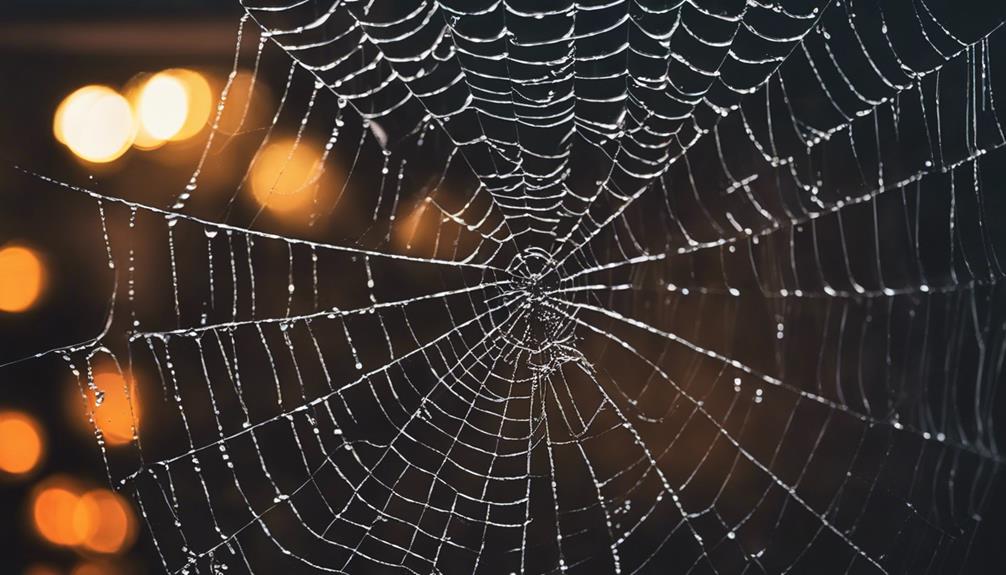
If you want your Halloween spider webs to withstand moisture and remain spooky, try experimenting with different waterproofing methods to find the most effective one. Here are some tips to help you maintain your spider webs for Halloween:
- Use clear Krylon spray can or gloss/semi-gloss finish for waterproofing spider webs.
- Test different waterproofing methods to find the most effective one for Halloween spider webs.
- Consider using a glue stick web gun or hot glue from a web caster gun for waterproofing.
- Utilize baby powder, fullers earth, or diatomaceous earth to enhance visibility and weatherproof spider webs.
Frequently Asked Questions
What Happens if a Spider Web Gets Wet?
If a spider web gets wet, it can lose its shape, weaken, become less visible, attract debris, and develop mold or mildew.
Water droplets weigh down the web, causing sagging and potential tearing. Moisture weakens silk strands, making the web more prone to damage.
In dim lighting or outdoors, wet webs are harder to see. To protect them, avoid exposure to rain or humidity and consider sheltering them indoors.
Do Spider Webs Get Ruined in the Rain?
When it rains, spider webs can indeed get ruined. Water can distort their delicate structure, making them less effective for catching prey or serving as spooky decorations.
Soggy webs are prone to tearing and may lose their stickiness. To prevent this, consider using waterproofing techniques or weather-resistant materials to shield Halloween spider webs from the rain.
How Do You Secure Fake Spider Webs?
To secure fake spider webs, start by using a clear Krylon spray or gloss finish. These will help protect the webs from getting wet.
You can also try a glue stick web gun or hot glue from a web caster gun for a secure hold.
Additionally, consider using baby powder, fullers earth, or diatomaceous earth to make the webs more visible and weatherproof.
Remember to stretch and re-anchor the webs as needed to keep them secure.
Reusing webs from previous years can save money and reduce waste.
Can You Put Fake Spider Webs Outside?
You can definitely put fake spider webs outside. Just make sure to choose water-repellant materials. Consider waterproofing techniques like clear Krylon spray or gloss finishes for protection.
Using durable tools like Minion's Web web guns or hot glue from a web caster gun can help. Properly anchoring and stretching the webs is key. Experiment with weatherproofing methods like baby powder or diatomaceous earth to keep them dry.
Conclusion
In summary, safeguarding Halloween spider webs from getting wet is essential for maintaining their spooky appearance. By selecting the right waterproof spray, applying it correctly, and placing the spider webs in covered areas, you can guarantee they stay dry and intact.
If the spider webs do get wet, make sure to dry them properly to prevent damage. By following these simple steps, you can enjoy your festive decorations all season long without any spooky surprises!
